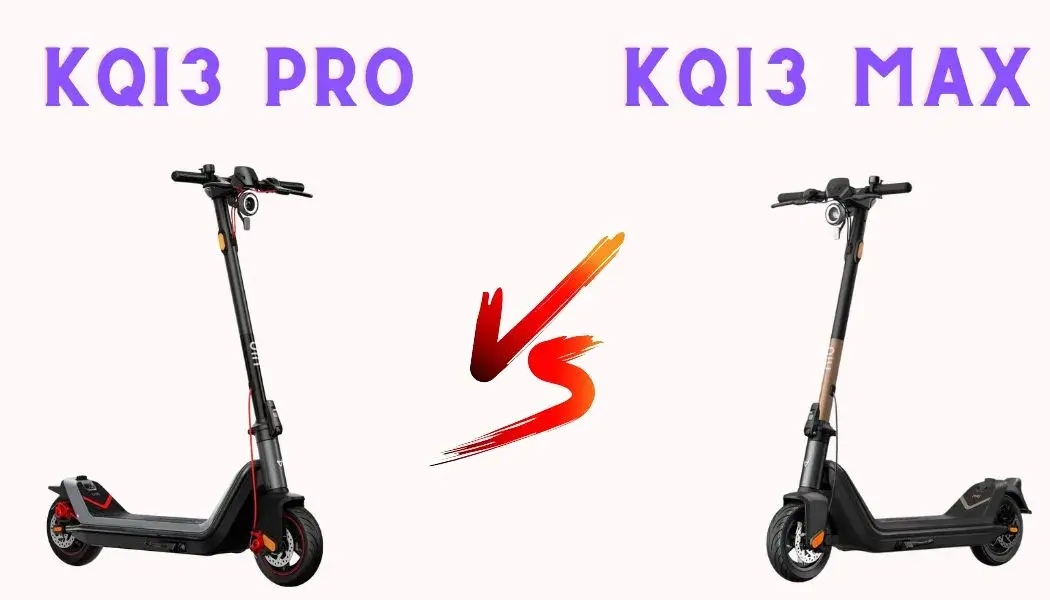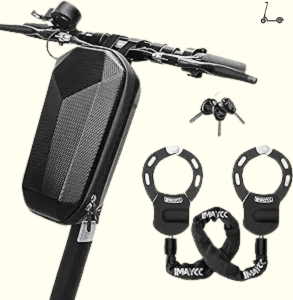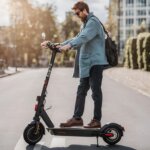Niu KQI3 Pro vs Niu KQI3 Max – two contenders in the world of urban mobility that offer an exciting blend of performance, design, and functionality. I have put extensive effort in researching the tiniest details of these scooters to write this article.
In this comprehensive article, we’ll take a closer look at the key specifications, build quality, performance, and features of both the Niu KQI3 Pro and KQI3 Max. Whether you prioritize performance, durability, or value for money, this comparison will help you decide which Niu scooter suits your specific needs and preferences.
Check out this All-Rounder Scooter as a Replacement!
EMOVE Cruiser S Electric scooter
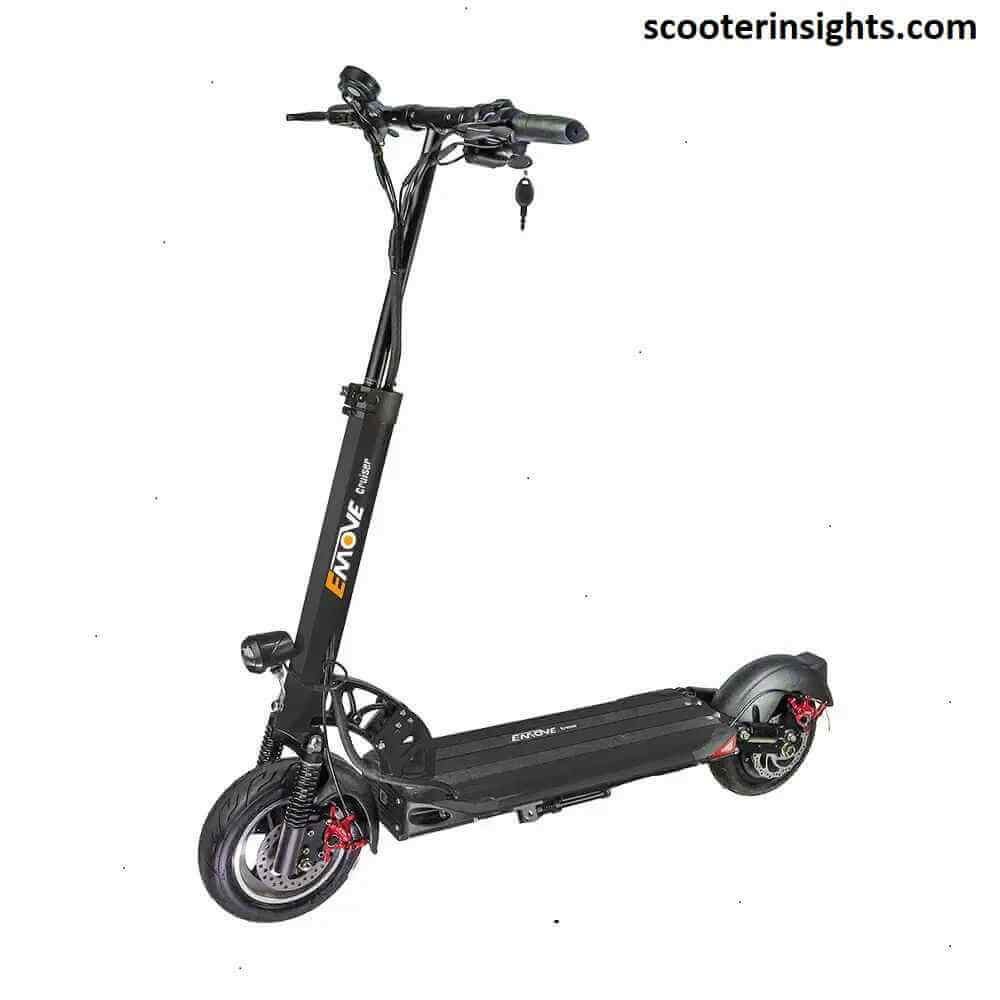
Value For Money, Affordable, Convenient & Very Customizable. Long Range & Security Concerned!
33 mph Top Speed, 62-mile Range, 56 lbs, max load 352 lbs, IPX6 Water rating, Foldable, Hybrid Hydraulic brakes, tubeless tires, LCD Display, Key Start ignition, Turn signals, Custom Throttles, Plug-and-Play cabling, 9-12 hours Charge Time.
Use Coupon Code “SCOOTERINSIGHTS” for Free DISCOUNT !!
Table of Contents
- 1 A. Niu KQI3 Pro vs KQI3 Max – Key Specifications
- 2 B. Build Quality & Design
- 3 C. Performance
- 4 D. Ride Quality, Comfort & Experience
- 5 E. Features
- 5.1 1. Assembly
- 5.2 2. Portability & Folding
- 5.3 3. Drive/Speed Modes
- 5.4 4. Display & Dashboard
- 5.5 5. Halo Headlight & Tail-Light
- 5.6 6. Turn Signals & Atmosphere Lights
- 5.7 7. Security & Safety
- 5.8 8. Battery Management System (BMS)
- 5.9 9. Water Resistance
- 5.10 10. Niu App
- 5.11 11. Customer Support
- 5.12 Which Scooter offers better Features?
- 6 F. Value & Worth for Money
- 7 KQI3 Pro vs Max – Conclusion
- 8 FAQs
A. Niu KQI3 Pro vs KQI3 Max – Key Specifications
| Niu Kqi3 Pro | Niu Kqi3 Max | |
| Motor Power | 350-700W | 450-900W |
| Top Speed | 20 mph | 23.6 mph |
| Max Range | 31 Miles | 40.4 Miles |
| Charge Time | 6 hrs | 8 hrs |
| Net Weight | 44.8 lbs | 46.5 lbs |
| Max Payload | 265 lbs | 265 lbs |
| Tires | 9.5” x 2.5” Tubeless Self Healing | 9.5” x 2.5” Tubeless |
| Price |
NIU KQI3
B. Build Quality & Design
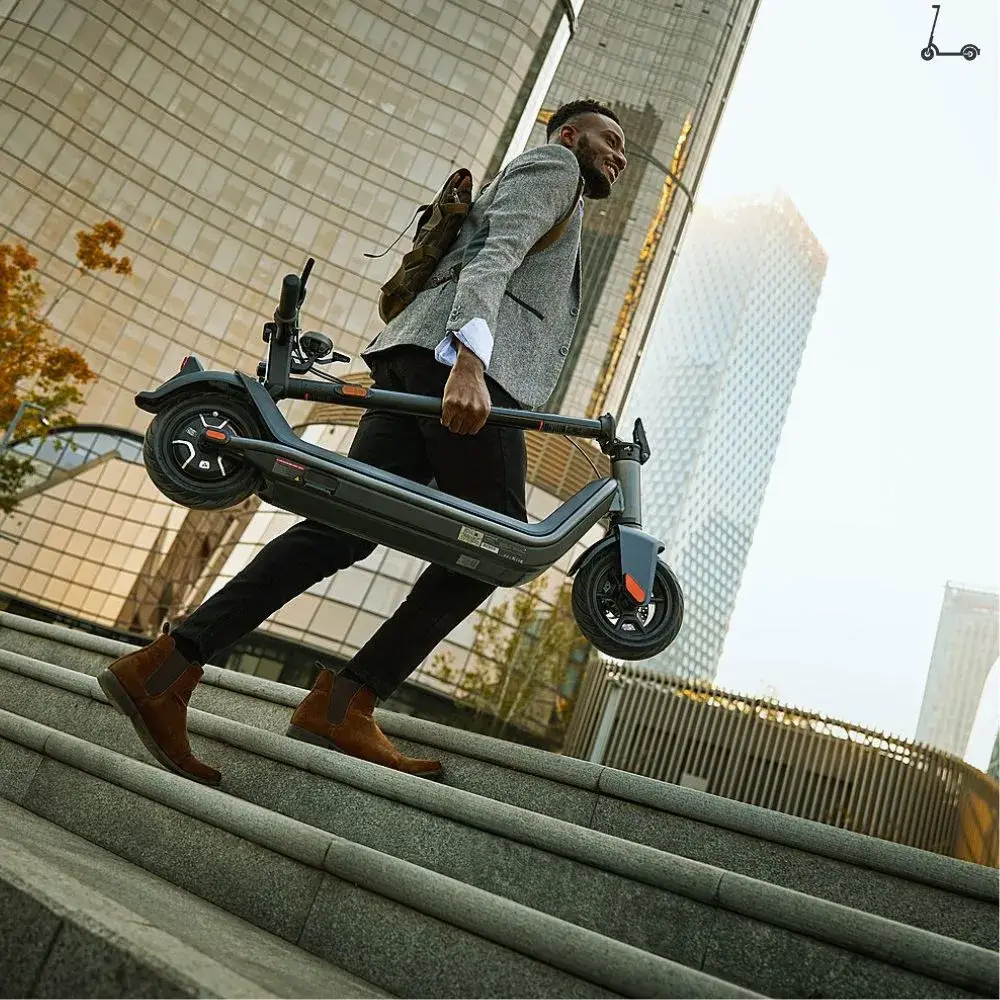
1. Foot Deck
The foot deck is a crucial component of an electric scooter as it plays a vital role in rider comfort and control. The Niu KQI3 Pro features a spacious and well-designed foot deck, measuring 22.4 inches (57.0 cm) in length and 6.7 inches (17 cm) in width.
Similarly, the Niu KQI3 Max also boasts a well-thought-out foot deck with dimensions of 23.5 x 6.7 inches, offering ample room for riders to position their feet comfortably. The Max model provides a slightly larger foot deck compared to the Pro, further enhancing rider comfort and control.
Both scooters have an inclined foot deck above the fender, acting as a footrest that provides extra control and maneuverability. This design feature allows riders to position their feet in various ways, enhancing the versatility of the deck. Additionally, the foot deck houses the scooter’s battery.
The rubber material covering the deck of both scooters provides excellent grip, ensuring a secure footing for riders. I have observed that the adhesive holding the rubber in place may weaken over time, requiring occasional re-adhesion. Nevertheless, the rubber surface, combined with the stylish “NIU WAY FORWARD” branding, adds to the overall aesthetic appeal of the scooters.
The deck height is 6.65 inches. The deck of this scooter is more spacious than many scooters, except the Emove touring, having a less grippy deck but more spacious deck.
2. Handlebars
The handlebars on both scooters share identical non-adjustable and non-collapsible designs. The build quality is generally robust, with occasional reports of screws holding the handlebar stem needing tightening, although this issue is not widespread.
The handlebars feature a comfortable wavy rubber grip and include a bell on the left side, a thumb throttle on the right side, and brake levers on both sides. The central portion of the handlebars houses a long rectangular display with a single multifunction button positioned at the bottom of the screen.
The handlebars’ height measures 47.3 inches, making it an average height. However, their width of 21 inches provides excellent control and handling, catering to riders with heights between 5’6″ and 6’3″. The stem is sturdy and reliable, as are the handlebars.
3. Dimensions
- Handlebar Length: 21.31 inches
- Handlebar Height: 47.3 inches
- Height after Folding: 19.8 inches
- Deck Length: 22.4 inches
- Deck Width: 6.7 inches
- Body Length: 46.2 inches
- Deck Height: 6.65 inches
- Ground Clearance: 2.9 inches
4. Net Weight
The KQI3 Pro weighs 44.8 lbs, while the KQI3 Max is slightly heavier at 46.5 lbs, only 1.6 lbs more than the Pro. This additional weight can be attributed to the upgraded battery and motor in the Max. These scooters are not considered lightweight for carrying over longer distances, but they are equipped with a WALK mode feature, which can assist in such situations.
The slightly heavier design of these scooters contributes to better stability and traction, while still maintaining excellent power and speed.
5. Max Payload
Both scooters have a maximum payload capacity of 264 lbs, and they promise to deliver maximum performance even under the maximum payload. Unlike some competitors, these scooters do not require compromising on payload capacity for performance, making them a solid choice in this regard.
6. Tires
Although these scooters lack a suspension system and shock-absorbing features, their 9.5-inch tires with a wider 2.5-inch profile ensure a smooth and comfortable ride. These tires handle uneven pavements, potholes, and cobblestones with ease, providing a stable and enjoyable riding experience without the discomfort and jolts associated with traditional scooters.
The wide and shock-absorbing tires offer excellent traction and stability, ensuring they do not skid when powerful brakes are applied. Many riders have reoprted that finding replacement wheels from third-party source can be challenging if the company does not provide them.
Additionally, their wider profile makes them more prone to punctures, so taking precautions such as using anti-puncture sealants can help make them puncture-resistant. Moreover, these tires are tubeless, which further contributes to their reliability.
The Max’s tires have a notable advantage in that they are self-healing and can automatically repair small punctures. The Apollo Air also have self-healing tires. This feature eliminates the risk and concern of experiencing a puncture during your ride. The red lining on the inner side of the Max’s tires, combined with the scooter’s red accents, adds a modern and appealing look to the overall design.
7. Durability
The Niu KQI3 Pro demonstrates excellent durability, surpassing many scooters under $1500 and even some high-performance scooters. It stands out for its robust build quality and is comparable to models like the Segway P65 and P100s. The Pro is notably durable, offering reliable performance over an extended period.
In contrast, the KQI3 Max may not be as durable as the Pro and the Ninebot Max, but only when subjected to harsh riding conditions. The Max’s upgrades, including a more powerful motor, battery, and brakes, have not fully addressed potential overheating issues. Consequently, if ridden aggressively or with heavy weight, the motor and battery may be more prone to overheating, and the brake discs could deform over time.
Overall, the Niu KQI3 scooters exhibit impressive build durability and construction, with the Pro being more durable, while the Max may require more careful handling to ensure longevity.
The only scooter having similar strong and long-lasting build is Ninebot Max G30.
8. Build Design
Both scooters share a similar robust build design, featuring sturdy handlebars and tillers with various color accent options. A modern touch is added by the Halo headlight at the front, and smart cable management keeps cables neatly hidden, with minor exposure near the base of the tiller’s folding mechanism.
The deck’s wavy and spacious design enhances the visual appeal of the scooters. While the fender is not prominent from above due to the deck’s coverage, it adds to the rear’s aesthetic.
The Max model’s fender light stands out with its pleasing shape. The tiller is bent by 15 degrees, contributing to a stable and efficient design.
Both scooters incorporate multiple reflectors and utilize some plastic elements in their design.
The KQI3 Pro is available in two colors: rose gold, with attractive rose gold accents on the tiller and rear section of the foot deck, and a fully black option. The deck has a slightly greyish tint in both models, distinguishing it from the scooter’s black color. The KQI3 Pro showcases a city-cruiser design that strikes a balance between modern and classic aesthetics.
On the other hand, the KQI3 Max is available in a single black color with vibrant red accents. These red accents extend to the tiller, deck, brake components, and tire inner linings. In terms of visual appeal, the KQI3 Max takes the lead, primarily due to its color scheme and the tail-light, while the fundamental build designs remain largely consistent.
Which Scooter Has Better Build?
While both scooters share similar build, the Pro is a bit more durable because the Max demands care, but the Max have more attractive look and better tires.
C. Performance
1. Motor & Power
The KQI3 Pro features a nominal motor power of 350W, which can peak at 700W during high demand. In contrast, the KQI3 Max boasts a 450W nominal power that can peak at 900W. It’s evident that the Max’s motor provides more power and torque for faster acceleration and better hill climbing.
The motor in the Max is brushless, ensuring a quieter operation with minimal noise.
2. Battery and Charging
Both scooters use superior 48V lithium-ion batteries. The Pro comes with a 486Wh battery, while the Max has a 608.4Wh capacity. These batteries deliver consistent energy, even when the charge level is low (at 10-15%).
This ensures that the scooters maintain the required power for extended range and top speed. The batteries are durable, protected by a Battery Management System (BMS) and carry an IPX4 water rating for longevity, similar to the Ninebot Max’s battery.
The battery compartments are integrated into the deck, with the charging port located on the left side, protected by a plastic cover. It’s important to be cautious when opening and closing this cover, as it utilizes a spring mechanism that can be delicate and prone to damage. This is a potential weak point in an otherwise robust scooter design.
Charging the KQI3 Pro takes approximately 6 hours, while the KQI3 Max requires around 8 hours, as they use 2-amp chargers, which might be slightly slower compared to some competitors.
The Apollo Air is a close competitor providing 34 miles range while getting charged in 5 hrs.
3. Range
The manufacturer advertises an ideal range of 31 miles for the Pro and 40 miles for the Max. In terms of range, the KQI3 Pro competes directly with the Emove Touring and Horizon 13, with the latter offering superior shock absorption thanks to its suspension. The Apollo Air Pro falls between the Niu KQI3 Pro and Max in terms of range. As for the KQI3 Max, it competes with the Gotrax Gmax Ultra and the Ninebot Max.
My Real-world testing research reveals that the KQI3 Pro covers approximately 14-15 miles under demanding conditions, including max weight, aggressive riding, and top speed in Sport mode. In more moderate conditions, like using ECO mode and medium weight, it achieves around 24 miles, with expectations of approximately 20 miles under maximum weight.
For the KQI3 Max, you can expect a range of 18-20 miles in Sport mode under aggressive riding conditions. Switching to ECO mode with medium weight could extend the range to 27-28 miles, and under lightweight and optimal conditions, you might reach up to 30 miles.
The GMAX Ultra has the highest range of 45 miles in budget scooters.
Regenerative braking enhances range by recovering energy when braking, and its strength can be adjusted through the app.
4. Top Speed
The advertised top speeds for these scooters are 20 mph for the Pro and 23.6 mph for the Max.
In real-world conditions, these speeds are reduced to approximately 18.5 mph and 22 mph, respectively. While some speed reduction is common in scooters, these Niu models maintain a smoother and more consistent speed, even when the battery level is as low as 15%.
The KQI3 Max is notably faster than the Pro and can achieve its advertised top speed with a maximum payload of 264 lbs. The Niu app is required to unlock the top speed after unboxing, with a 500-meter travel requirement before unlocking speed modes.
For even higher top speeds consider the Horizon or the Emove touring, sacrificing the build durability and spacious deck.
5. Torque & Acceleration
The 700W max power of the KQI3 Pro and the 900W max power of the Max are impressive. Despite their slightly heavier nature, they are among the fastest scooters in the $1000 price range. The acceleration is smooth and gradual, and the motor provides ample torque for climbing hills.
My research of real-world acceleration testings shows that the KQI3 Pro accelerates from 0-15 mph in just 5-6 seconds, while the Max achieves this in 4-5 seconds. These acceleration figures are remarkable. Some may find the Max’s acceleration a bit too quick, but the inclined part of the deck provides stability and control. Even at such rapid acceleration, the scooter remains stable.
The KQI3 Max is notably faster than the Pro.
6. Braking
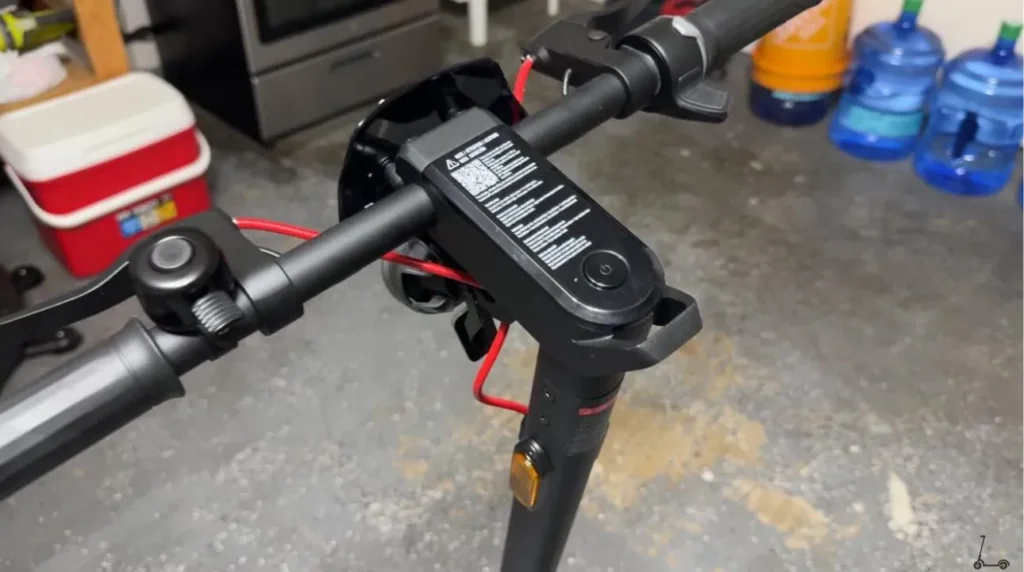
Both the Niu KQI3 Pro and Niu KQI3 Max come equipped with dual mechanical disc brakes, a significant safety feature in electric scooters. These disc brakes are of high quality, with disc calipers squeezing the disc from both sides. The braking performance of these scooters, especially the KQI3 Max, outperforms other scooters under $1000, as reported by various scooter expert websites like Rider Guide and Scooter.guide.
There are key differences in their braking performance and features:
The Niu KQI3 Pro, with its dual lever brakes, well-built design, and anti-skid tires, can stop within an impressive 10-12 feet from 15 to 0 mph, demonstrating exceptional braking efficiency and rider safety.
The Niu KQI3 Max takes the braking system to the next level, with superior disc calipers offering precise control over braking force. It requires only 9-11 feet to come to a stop from 15-0 mph, even without skidding. This level of braking performance sets a high standard in the electric scooter industry, making the Max a standout performer in this aspect.
The Max offers more stopping power than any scooter in its price range.
7. Regenerative Braking
Both the Niu KQI3 Pro and Max feature regenerative braking. It engages when you release the throttle or apply the brakes, gradually increasing as the brake lever is pressed harder.
This system contributes significantly to extending battery life and improving overall scooter efficiency by recapturing energy during braking. It ensures a smooth and controlled deceleration and enhances rider safety by allowing the scooters to come to a stop within a short distance.
Riders can adjust the regen strength through the Niu app, although the variation in regenerative intensity is not substantial.
8. Hill Climbing
The scooters are designed with hill climbing in mind. The KQI3 Pro can climb inclines of up to 20%, while the KQI3 Max is capable of tackling hills with a 25% incline. I researched that the Pro maintains a speed of 8.5 mph on a 10% incline, while the Max can reach 10 mph with a weight of around 240 lbs.
Therefore, the Max is better suited for hill climbing compared to the Pro.
While both scooters excel at hill climbing, it’s worth noting that the Pro’s tires may be more susceptible to punctures. These scooters are best suited for paved hills, as they have low ground clearance and are not designed for rough and rocky terrains.
The Max outperforms the Emove, Apollo Air, Horizon and the GMAX in hill climbing. It rivals the Ninebot Max in hill climbing.
Which Scooter Has Better Performance?
In terms of overall performance, the KQI3 Max is the clear winner. It offers better acceleration and braking power, extended range, and a higher top speed, making it a top choice in the $1000 price range.
D. Ride Quality, Comfort & Experience
1. Kick Start
The kick start on these scooters is a bit of a hassle. Firstly, you have to push them more than their competitors to kick start them. Secondly, you cannot pre-hold the throttle for kick start. You will have to first push to the starting speed and then push the throttle.
I would also like to clarify the confusion about whether this scooter is a zero start or kick start? These scooters do support a zero start feature accessible by an app, but it’s for some specific app and firmware versions, and also depends on the region. So, it isn’t confirmed which version and region is required for zero start.
2. Handling & Control
With a wheelbase of nearly 45 inches, the scooter balances between stability, maneuverability, handling, and portability. It is the optimal length for a budget city commuter. While the 21.5 inches long handlebars are just perfect for handling and portability.
The pneumatic tubeless and wide tires absorb minor bumps, and you will not lose control when on bumpy roads.
A 3-cm ground clearance makes it extremely stable for even terrains, and the deck has grippy wavy rubber. The tires are wide and grippy and won’t lose traction even when downhill.
The inclined deck, when one foot is placed on this incline, gives an optimal riding position for the best control of the scooter.
The Max is also as stable and controllable as the Pro at higher speeds. The brakes are responsive and stronger than the Pro. While these scooters may not turn quickly and maneuver through tight corners like the Ninebot Max or the Apollo Air Pro, they offer a more stable and safe ride.
Both scooters are extremely stable and safe to ride at high speeds, competing with the TCS technology of the Ninebot Max G2, although they might not be as agile as the Horizon.
3. Suspension & Shock Absorption
The scooters are not equipped with special suspension. Instead, they use the tires for this purpose. The tires of these scooters are designed to provide a smooth ride and absorb shocks on bumpy roads. The tires are also designed wider and larger than average budget scooters for this purpose. The tires are tubeless, or rather what Niu calls “vacuum tires” for more shock absorption.
They are susceptible to punctures, but the Max’s tires are self-healing.
However, at the Max’s top speed of 22mph, the ride does not feel as good as at 19mph on the Pro. Still, I can confirm that when it comes to average city roads, at 19mph (the max speed of the Pro), there is no scooter more comfortable except for the Horizon 13 and Ninebot Max G2.
Both scooters provide exceptional shock absorption on city roads.
4. Off-Roading
Simply put, these scooters are not designed for off-roading, though slight off-roading is not an issue. As I mentioned earlier, they lack suspension for off-roading and are not designed for that purpose.
You should not use the Pro for off-roading, while the Max’s tires are durable for off-roading. The issue is not that they lack build sturdiness, tire grip, or off-road performance, but it’s because of the discomfort you might feel.
Again, slight off-roading won’t be an issue for both.
The Max is a bit more suitable for rocky off-roading, but the Pro is not.
For off-roading , the emove touring and the Ninebot Max G2(having TCS feature) are better options.
5. Input & Throttle Controls & Cruise Control
Although the controls come from one multi-function button located in the middle of the handlebars, at the bottom of the screen, I would recommend a feature-rich scooter like this to be controlled by multiple buttons. The control button located at the center of the handlebars is not convenient, as it should be placed near the thumbs since riders might lose balance at high speed when adjusting controls. Also, there are plenty of settings only available in the app, not on the scooter.
- One long click turns the scooter on.
- With the scooter on, one short click changes speed modes.
- Two clicks toggle the headlight on or off.
- Three clicks change the mileage units from miles to kilometers and vice versa.
- Five clicks put the scooter into walk/pedestrian mode.
The throttle is just the right balance between resistance and softness. The throttle increases acceleration gradually, making it smooth. The design of the thumb throttle is a common one, and it is located on the right grip. Acceleration is super smooth for the throttle. The throttle has the best resistance, shape, and comfort. Holding the throttle for 5 seconds engages cruise control with an audible beep.
Which Scooter Gives a Better Ride Experience?
Both scooters provide the same excellent ride comfort, safety, convenience, and experience. The input control system might be inconvenient for some users.
E. Features
1. Assembly
The NIU KQI3 Pro is an excellent choice for both novice and experienced e-scooter riders due to its remarkably easy assembly process. Setting it up is a breeze, requiring minimal effort. Simply connect the mainline connector, insert the handlebar, secure it with four screws, and you’re good to go.
Unlike some scooters that demand a more strenuous brake line setup, the KQI3’s simplicity is a significant advantage. It even arrives partially charged, allowing for immediate practice. While you can ride without the app, linking it provides access to additional features.
The scooter’s safety-conscious approach is evident in its requirement of traveling 200 meters before unlocking the Sport riding mode, ensuring riders are well-prepared before experiencing its full 20 mph top speed.
2. Portability & Folding
The portability and folding mechanisms of the Niu KQI3 Pro and Niu KQI3 Max electric scooters are essential aspects for riders who need to transport their scooters conveniently. Both scooters feature a two-step folding mechanism that makes them highly portable and easy to store. This folding process is user-friendly and quick, ensuring that riders can fold and unfold their scooters with minimal effort. Here’s how the folding process works:
- Step 1 – Unlocking the Folding Mechanism: Riders can begin by sliding the locking mechanism, which releases the scooter’s folding mechanism. This step is essential to prevent the tiller (the part you hold onto while riding) from accidentally opening during transportation.
- Step 2 – Tiller Folding: After releasing the locking mechanism, riders need to apply a slight downward force on the latch, which releases the tiller and allows it to fold down. This step ensures that the scooter remains securely folded for transportation.
Additionally, a practical feature is the automatic lock on the fender, which clicks into place when the scooter is locked, providing an added level of safety and preventing the scooter from unfolding accidentally.
Unfolding the scooter is also straightforward, as it only requires pressing a button to unlock the fender lock and locking it in an upright position with the tiller lock. The folding mechanism used in these scooters is appreciated by many users for its speed, reliability, and durability. It’s designed to withstand frequent folding and unfolding without getting damaged, setting them apart from other budget scooters.
At nearly 45 pounds, the scooters are a little bit on the heavier side, but this is why they have the Walk Mode feature. You can walk with the scooter at a speed of 3 mph by holding the throttle.
The folded dimensions of 46 inches in length, 20 inches in height, and 21 inches in width are easily manageable and compact for storage. Both scooters have the same folded dimensions.
For more portability, consider the Horizon having folded dimensions of 38.6 x 7.1 x 14.6 inches.
3. Drive/Speed Modes
When you first unbox the scooter, it is limited to 6 mph. After unlocking the app and traveling some distance, you unlock three speed modes: ECO, SPORTS, WALK. There is also the option to set up custom speed modes, but it’s only available through the app, which then overrides other speed modes of the scooter until disabled again through the app. The ECO mode pushes the speed to 9 mph, while the SPORTS mode delivers faster acceleration and reaches the top speed.
The walk mode is a useful feature for these scooters since they are heavier than their competitors.
4. Display & Dashboard
The display is in the form of pixels. Some may find it uninteresting, but it’s bright. I have observed that turning on the light dims the display slightly to conserve battery for a longer ride.
5. Halo Headlight & Tail-Light
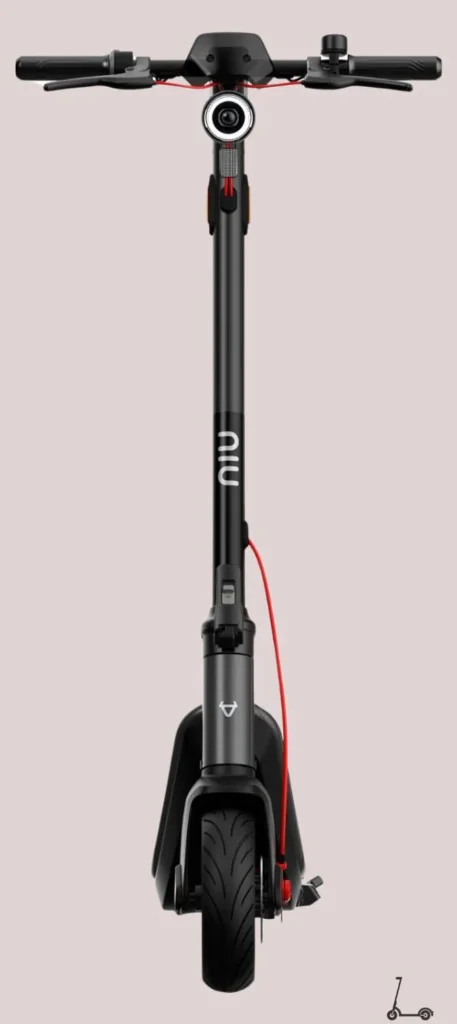
The Niu KQI3 Pro and Niu KQI3 Max electric scooters feature a distinctive and stylish lighting system. The highlight of the lighting setup is the Halo headlight, which adds a modern and cool look to the scooters. This unique headlight consists of an outer ring of light that is always on and a bulb located inside the ring, which emits a very bright and powerful beam of light.
There is no need for extra lighting on the scooter.
The tail light is constantly illuminated and becomes even brighter when the brakes are applied, which is a useful safety feature. One potential improvement riders suggest could be to make them blink. The tail light on the Niu KQI3 Max is a little bit broader than the Pro, making it visually more appealing.
6. Turn Signals & Atmosphere Lights
Turn and atmosphere lights are not available on these scooters, which is a slight drawback. However, there are many reflectors on the scooter. There are two reflectors on the side of the fender, two on the front wheel sides, two on the sides below the handlebar, and one under the headlight.
7. Security & Safety
I will address the only safety flaws. First of all, the apps need to be connected with the scooter to use the anti-theft lock, which uses data or the internet too. Secondly, there is the absence of turn signals on these 20 mph scooters. Lastly, the control button is located at the center and is not conveniently accessible in the middle of speedy rides.
However, besides these reasons, the scooters are safe, have a reliable build, stable design and construction, powerful brakes, a loud bell, and are easy to handle.
If you wish a more anti-theft scooter, check out the GMAX Ultra, having integrated cable and digital locks.
8. Battery Management System (BMS)
The scooters use an intelligent BMS for battery preservation and longevity.
9. Water Resistance
The scooters have a water rating of IPX4, suitable for light water splashes and very light rain. At this price, I have seen many scooters with IPX5 and IPX6 ratings, such as the Apollo Air Pro, Horizon 13, Emove Touring, Gotrax G3/G4, GMAX, and Turboant V8. As a result, these scooters are not suitable for areas with heavy rains and rainy weather.
10. Niu App
The Niu app competes with the Segway Ninebot app in terms of features and advanced controls.
You can access information about your rides and find various controls not available on scooter manually.
One unique thing you can do, compared to very budget scooters, is the setting of custom speed modes, aside from the default modes.
You can set a custom speed limit for custom speed modes through the app. You need to turn on/off custom speed every time you need to switch to eco or sports mode. After reading user reviews and experiences, I think that it would be better if you could switch between custom speed modes and default (Eco, Speed) modes simultaneously, instead of just locking onto the custom mode.
The app demands continuous data/internet as it tracks location all the time.
11. Customer Support
Customer support for Niu electric scooters has seen noticeable improvement, although it may not yet be considered excellent. The company has actively addressed previous shortcomings and is working to enhance its support services. Users can access warranty benefits, including part replacements, which is a valuable resource for addressing issues during the warranty period.
Which Scooter offers better Features?
Both scooters have similar features. They offer nice basic features and a feature-rich app.
F. Value & Worth for Money
The estimated price of Niu KQI3 Pro is 750$ and KQI3 Max is $950. The price difference of $200 between the Niu KQI3 Pro and KQI3 Max appears to be justifiable given the considerable improvements and advantages offered by the Max in various aspects such as build design, power, braking, and self-healing tires.
These scooters strike a balance between affordability and quality, making them a cost-effective choice. When they are on sale, they become even more appealing. They outperform competitors like Segway Ninebot, Apollo, and Emove in terms of value for money, making them a compelling option for small, peaceful city rides.
KQI3 Pro vs Max – Conclusion
I will summarize the Niu KQI3 Max vs Niu KQI3 Pro in these 3 points.
- If you prioritize performance, better braking, and self-healing tires, the KQI3 Max is the clear choice.
- If you’re looking for a more durable battery and motor, the KQI3 Pro is a suitable option.
- Both scooters offer a comfortable and safe riding experience, strong construction, attractive designs, good portability, worth for money and excellent perfomance. Your choice should align with your specific preferences and priorities.
Ultimately, your decision between the Niu KQI3 Pro and KQI3 Max should be based on your individual needs and preferences, as both scooters offer a good balance of features, value, and performance for their respective price points.
FAQs
-
What are the key specifications of the Niu KQI3 Pro and KQI3 Max electric scooters?
Key specifications include motor power (350W for Pro, 450W for Max), top speed (20 mph for Pro, 23.6 mph for Max), max range (31 miles for Pro, 40.4 miles for Max), charge time (6 hrs for Pro, 8 hrs for Max), net weight (44.8 lbs for Pro, 46.5 lbs for Max), max payload (265 lbs), and 9.5” x 2.5” tubeless tires.
-
How is the build quality and design of the foot deck in the Niu KQI3 Pro and KQI3 Max?
Both scooters feature spacious and well-designed foot decks with rubber covering for excellent grip. The foot decks provide ample room for comfortable foot placement and can also serve as a footrest for added control and maneuverability.
-
Do the Niu KQI3 Pro and KQI3 Max scooters have adjustable handlebars?
No, both scooters have non-adjustable handlebars. The handlebars are 21 inches wide, providing good control and handling for riders between 5’6” and 6’3”.
-
What is the range of the Niu KQI3 Pro and KQI3 Max in real-world riding conditions?
In real-world conditions, the KQI3 Pro covers approximately 13-14 miles with max weight, aggressive riding, and top speed sports mode. The KQI3 Max offers a minimum range of 20 miles under similar conditions and can reach up to 30 miles in optimal situations.
-
Which Niu scooter has better performance, the Pro or the Max?
The KQI3 Max offers better performance with a more powerful motor, faster top speed, and improved braking capabilities compared to the KQI3 Pro. However, the Pro has more durable battery and motor components. Your choice should depend on your priorities.
I’m Arsalan Ahmed, a passionate electric scooter enthusiast and the voice behind this blog. I’m here to share my expertise and insights with you. From in-depth reviews to problem-solving guides, my goal is to help you make the most of your electric scooter experience.
